tire size AUDI Q5 2014 Owners Manual
[x] Cancel search | Manufacturer: AUDI, Model Year: 2014, Model line: Q5, Model: AUDI Q5 2014Pages: 316, PDF Size: 78.41 MB
Page 151 of 316

Safety belts
General notes
Always wear safety belts!
Wearing safety belts correctly saves lives!
This chapter explains why safety belts are necĀ
essary, how they work and how to adjust and
wear them correctly.
~ Read all the information that follows and
heed all of the instruc tions and WARNINGS.
A WARNING
Not wearing safety belts or wearing them
improperly increases the risk of serious
personal injury and death.
- Safety belts are the single most effective
means available to reduce the risk of seĀ
rious injury and death in automobile acciĀ
dents. For your protection and that of
your passengers, always correctly wear
safety belts when the vehicle is moving.
- Pregnant women, injured, or physically
impaired persons must also use safety
belts. Like all vehicle occupants, they are
more likely to be seriously injured if they
do not wear safety belts. The best way to
protect a fetus is to protect the mother -
throughout the entire pregnancy.
Number of seats
Your Audi has a total of five seating positions:
two in the front and three in the rear. Each
seating position has a safety belt.
A WARNING
Not wearing safety belts or wearing them
improperly increases the risk of serious
personal injury and death.
- Never strap more than one person, inĀ
cluding small children, into any belt. It is
especially dangerous to place a safety
belt over a child sitting on your lap.
- Never let more people ride in the vehicle
than there are safety belts available.
Safety belts 149
-Be sure everyone riding in the vehicle is
properly restrained with a separate safeĀ
ty belt or child restraint.
Safety belt warning light
Your vehicle has a warning system for the
driver and (on USA models only) front seat
passenger to remind you about the imporĀ
tance of buckling-up.
Fig. 154 Safety belt warning light in the instrument
cl uster -enla rged
Before driving off, always:
~ Fasten your safety belt and make sure you
are wearing it properly.
~ Make sure that your passengers also buckle
up and properly wear their safety belts.
~ Protect your children with a child restraint
system appropriate for the size and age of
the children.
The warning light . in the instrument cluster
light s up when the ignition is switched on as a
reminder to fasten the safety belts. In addiĀ
tion, you will hear a warning tone for a certain period of time.
Fasten your safety belt now and make sure
that your passengers also properly put on
their safety belts.
A WARNING
- Safety belts are the single most effective
means available to reduce the risk of seĀ
rious injury and death in automobile acciĀ
dents. For your protection and that of
your passengers, always correctly wear safety belts when the vehicle is moving.
ā¢
ā¢
Page 200 of 316

198 Intelligent technology
Dynamic ste ering *
On vehicles with dynamic stee ring* , ES C helps
stabilize the st eering in critical s ituations .
Selective wh eel torque c ontrol
The selective whee l torque control operates
when dr iv ing through curves . T he front wheel
on the inside of the curve or both wheels on
the inside of the curv e are braked selective ly
as needed. This m inimizes sliding in the front
wheels and allows for more pr ecise driving
through curves . T he system may not act ivate
when driving in wet or snowy cond itions .
A WARNING
-ESC, ABS, ASR, EDL dynamic steering"
and the se lective wheel torque control
cannot overcome the laws of physics .
Th is is especially important on slippery
or wet roads.
If the systems begin act ing
to stabilize yo ur vehicle , you sho uld imĀ
med iately change your speed to ma tch
the road and traffic condit ions. Do not
let the increased safety provided by
these systems tempt you to take risks. Do ing so wi ll increase the risk of a loss of
vehicle control, collision and serious perĀ
sonal injuries .
- Always adapt your speed to road, traff ic
and weather condit ions. The risk of Los-
ing cont ro l of the veh icle increases when
Switching on/off
-
driving too fast, espec ially through
curves and on slippery or wet roads, and
when dr iv ing too close to vehicles up
ahead . ESC, ABS, the brake ass ist sysĀ
tem, ASR, ED L, dynam ic steering* and
the selective whe el torque cont ro l canĀ
not p revent collisions.
- Always accelerate with special care on
even, smooth surfaces such as those that
are wet or covered with ice and snow.
The drive wheel s can spin eve n w ith
these assistance sys tems t hat can not al Ā
ways he lp to red uce the risk of loss of veĀ
hicle control.
(0 Tips
- ABS and ASR only work correctly when
all four whee ls are equipped wi th identi Ā
cal tires . Different tire sizes can lead to a
reduction in engine powe r.
- Yo u may hear noises when the systems
described are working .
-If the ind icator light&] or llB (USA
mode ls)/ [iJ (Canada models) appears,
there may be a malfunction
c:::, page 15,
c:::, page 17.
-When installing a factory-supplied roof
rack system on the roof railing, the ESC
w ill adapt itse lf to a different center of
gravity.
ESC turn s on automa tically when you star t the engine .
Fig . 18 5 Ve rs io n A: L ower ce nte r conso le , fJ. O FF b utĀ·
to n Fig. 186 Ve rs io n B: Uppe r ce nte r co nso le, fJ. OF F bu tĀ
t on
Page 204 of 316

202 Intelligent technology
iT-ij Dynamic steering: System fault! You can
cont inue driving
If the indicator light turns on and the mesĀ
sage appears, the steer ing may be more diffiĀ
cult to move or more sensitive than usual. The
steering may also be at an angle when driving
straight.
Drive slow ly to your authorized Audi dealer or
qualified workshop to have the malfunction
corrected .
iT-ij Dynamic steering: Initializing
Audi drive select*: if the indicator light blinks
and the driver message appears, the dynamic
steer ing* is reinitialized. Once you sta rt the
engine after this is finished, the steering
wheel will be easy to move. Re-ini tialization
might be necessary if the steering wheel was
moved hard to the left and right while the veĀ
h icle was not moving . The display turns off if
the initiali zation was successful.
- If the . or
tTij indicator light on ly stays
on for a short time, you may continue
driving.
- The dynamic steering* stability systems
Ā¢
page 197 are not available in the event
of a system malfunction.
- For additional information on dynamic
steering* Ā¢
page 120.
Driving with your
quattro
With all-wheel drive, all four wheels are drivĀ
en.
General information
W ith all-wheel dr ive, power is distributed to
all four wheels. This happens automatically
depending on your driving sty le and the road
conditions at the time . See also Ā¢
page 197.
A center different ial distr ibutes the dr iv ing
power var iably to the front and rear axle . It
works together with se lective wheel torque control, which activates when driving through
curves
r=:>
page 198.
The all-wheel drive concept is designed for
high eng ine power. Your veh icle is except ion Ā
ally powerfu l and has excellent driving characĀ
teristics both under normal driving conditions
and on snow and ice . Always read and follow
safety precaut ions r=;,
,&.
Winter tires
When driving in the winter, your vehicle with
all-wheel drive has an advantage, even with
regular tires. In winter road conditions it may
be advisable to mount winter tires (or all-seaĀ
son tires) for improved driveability and brakĀ
ing : these tires must be mounted on
all four
wheels.
See also r=;, page 262, Winter tires.
Tire chains
Where tire chains are mandatory on certain
roads, this norma lly also app lies to veh icles
with all-wheel driver=;,
page 263, Snow
chains .
Replacing wheels/tires
Vehicles with a ll-wheel drive must always
have tires of the same size. A lso avoid tires
with different tread depths. For deta ils see
page
r=;, page 2 SB, New tires and replacing
tires and wheels.
A WARNING
-Always adjust your dr iv ing to road and traf-
f ic conditions. Do not let the extra safety
afforded by all-wheel drive tempt you into
taking extra risks .
- Although the all-wheel drive is very efĀ
fective, always remember that braking
capacity is lim ited by tire traction. You
should therefore not drive at excessive
speeds on icy or slippery road surfaces.
- On wet road surfaces, be careful not to
drive too fast because the front wheels
could begin to slide on top of the water
(aquaplaning). If this should occur, you
will have no warning from a sudden inĀ crease in eng ine speed as w ith a frontĀ
wheel drive veh icle. Always drive at
Page 251 of 316
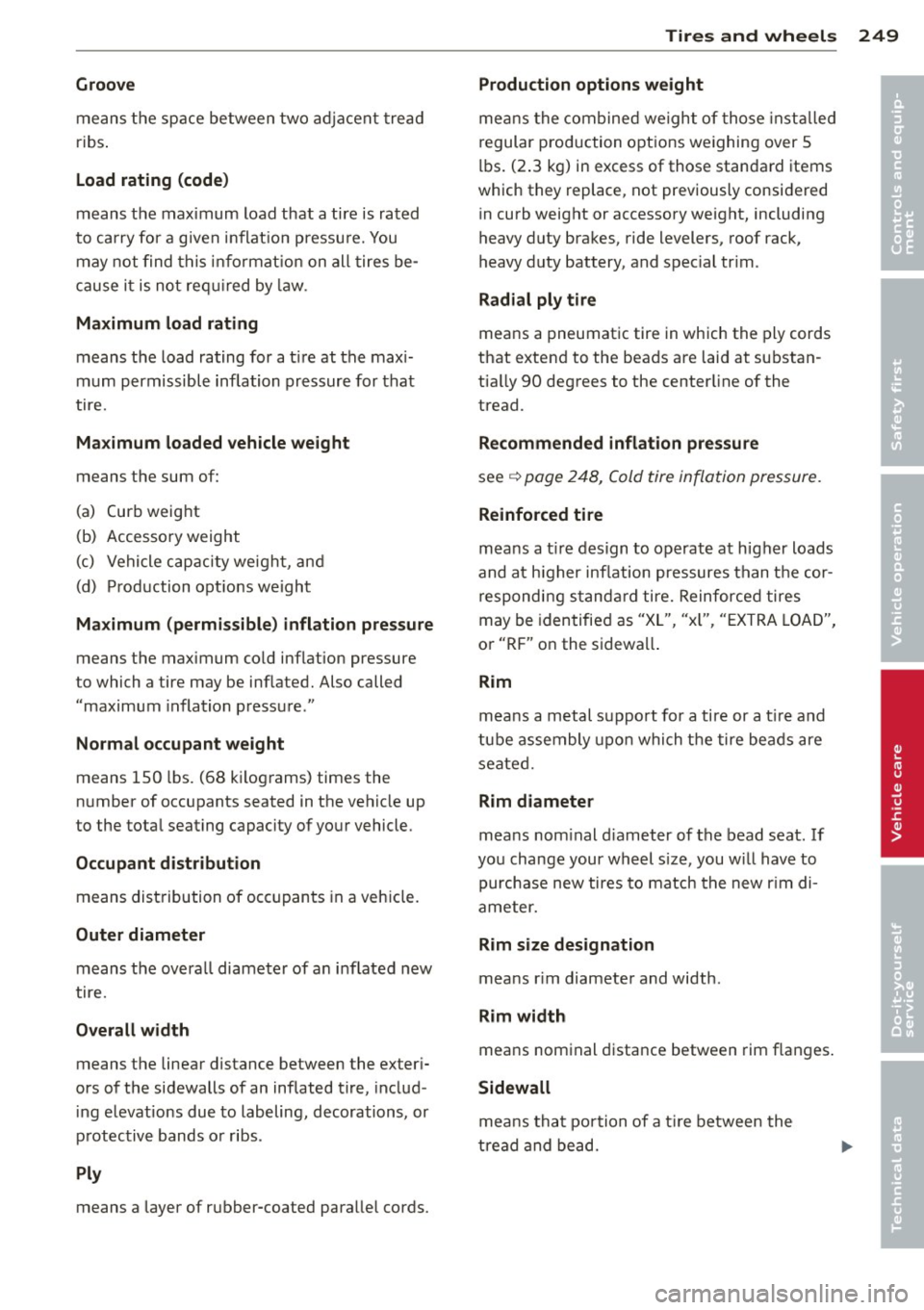
Groove
means the space between two adjacent tread
ribs.
Load rating (code)
means the maximum load that a tire is rated
to carry for a given inflation pressure. You
may not find this information on all tires beĀ
cause it is no t req uired by law.
Maximum load rating
means the load rating for a t ire at the max iĀ
mum permissible inflation pressure for that
tire.
Maximum loaded vehicle weight
means the sum of:
(a) Curb weight
(b) Accessory weight
(c) Vehicle capacity weight, and
(d) Production options weight
Maximum (permissible) inflation pressure
means the maximum cold inflation pressure
to which a tire may be inflated. Also called "maximum inflation pressure."
Normal occupant weight
means 150 lbs. (68 kilograms) times the
number of occupants seated in the vehicle up
to the total seating capacity of your vehicle.
Occupant distribution
means distribution of occupants in a vehicle.
Outer diameter
means the overa ll diamete r of an inflated new
tire.
Overall width
means the linear distance between the exteriĀ
ors of the sidewalls of an inflated tire, includ Ā
in g elevations due to labeling, decorations, or
protective bands or ribs.
Ply
means a layer of rubber-coated parallel cords.
Tires and wheels 249
Production options weight
means the combined weight of those installed
regular production options we ighing over 5
lbs. (2.3 kg) in excess of those standard items
which they replace, not previously considered
in curb weight or accessory weight, including
heavy duty brakes, ride levelers, roof rack,
heavy duty battery, and spec ial tr im .
Radial ply tire
means a pneumatic tire in which the ply cords
that extend to the beads are laid at substanĀ
tia lly 90 degrees to the center line of the
tread .
Recommended inflation pressure
see Ā¢ page 248, Cold tire inflation pressure.
Reinforced tire
means a t ire design to operate at higher loads
and at h igher inflation pressures than the corĀ
re sp onding standard tire. Reinforced tires
may be identified as "XL", "xl", "EXTRA LOAD",
or "RF" on the sidewa ll.
Rim
means a metal support for a tire or a t ire and
tube assembly upon which the tire beads are
seated.
Rim diameter
means nom inal diameter of the bead seat. If
you change your wheel s ize, you will have to
purchase new tires to match the new rim diĀ
ameter.
Rim size designation
means r im diameter and width .
Rim width
means nominal distance between rim flanges .
Sidewall
means that portion of a tire between the
tread and bead.
ā¢
ā¢
Page 253 of 316
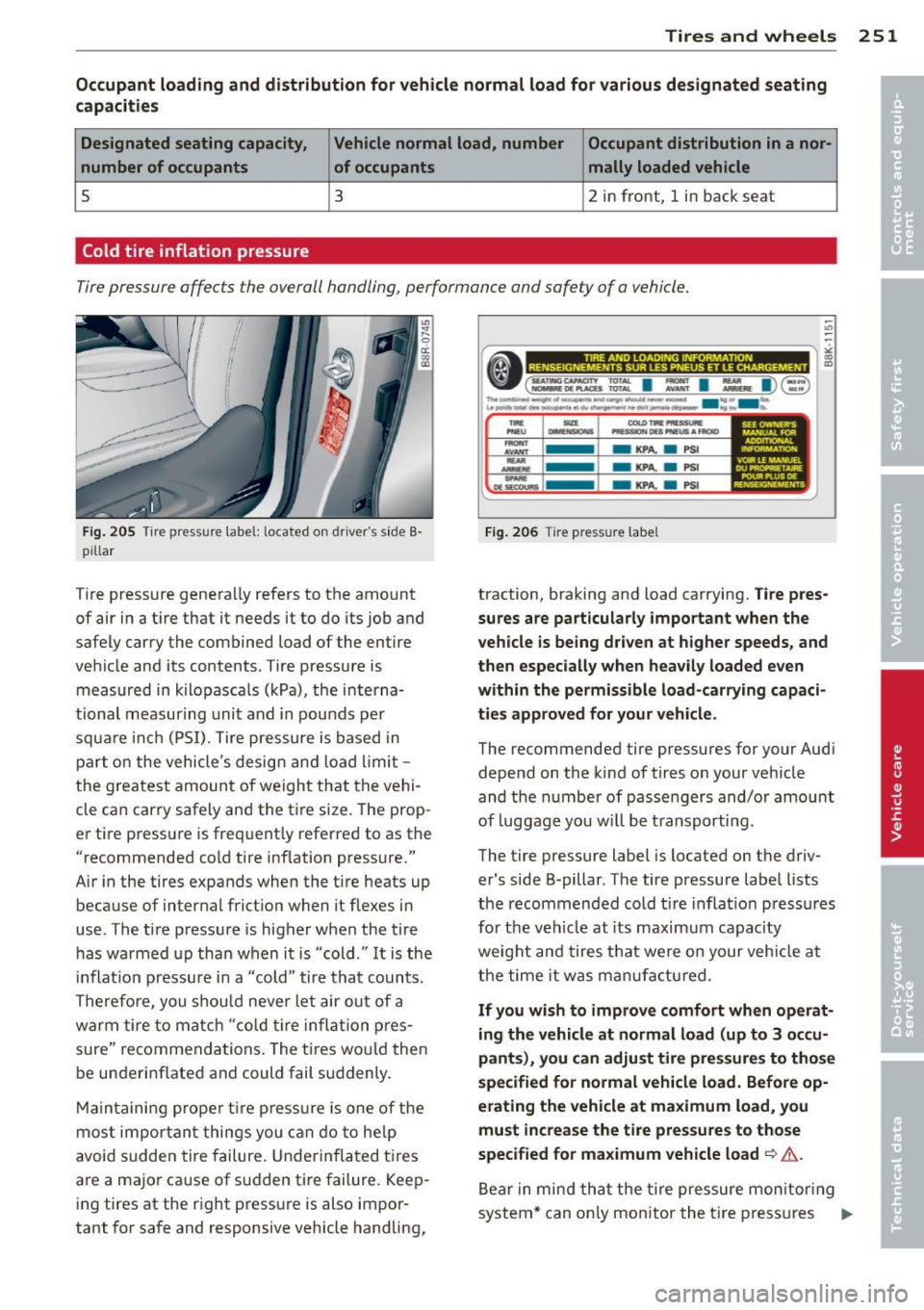
Tires and wheels 251
Occupant loading and distribution for vehicle normal load for various designated seating
capacities
Designated seating capacity, Vehicle normal load, number Occupant distribution in a nor-
number of occupants of occupants mally loaded vehicle
5 3 2 in front, 1 in back seat
Cold tire inflation pressure
Tire pressure affects the overall handling, performance and safety of a vehicle.
Fig. 205 Tire press ure label: located on driver 's s ide BĀ·
p ill ar
Tire pressure generally refers to the amount
of air in a tire that it needs it to do its job and
safely carry the combined load of the entire
vehicle and its contents . Tire pressure is
measured in kilopasca ls (kPa), the internaĀ
tional measuring unit and in pounds pe r
square inch (PSI). Tire pressure is based in
part on the vehicle 's design and load limit -
the greatest amount of weight that the vehiĀ
cle can carry safe ly and the t ire size . The propĀ
er tire pressure is frequent ly referred to as the
"recommended cold tire inflation pressure."
Air in the tires expands when the tire heats up
because of internal friction when it flexes in
use . The tire pressu re is higher when the tire
has warmed up than when it is "cold ."
It is the
in flat ion pressure i n a "cold " tire that counts.
Therefo re, you shou ld neve r let air out of a
warm tire to ma tch "cold tire inflat ion presĀ
sure" recommendations. The tires would then
be underinflated and could fail suddenly .
Maintaining proper tir e pressure is one of the
most impor tant things you can do to help
avoid sudden tire failure. Underinflated tires
are a ma jor cause of s udden tire failure . KeepĀ·
ing tires at the right pressure is also imporĀ
tant for safe and responsive vehicle handling,
-tD
-
---------------------.. ,;
ā¢(==.: I :::; I :,,. I)@ gi n. ............ .,_____, .... -.ito._.. ____ .... _ ...
&..p0idit,101111-~--.,...,....-- ..... ~ .... ..
-Ā·Ā·-Ā.....
-
-Dlst<:OURS
- KPA.. a PSI
- KPA..
a PS I
- KPA.. a PSI
Fig. 206 Tire pressu re labe l
traction, braking and load carrying. Tire presĀ
sures are particularly important when the
vehicle is being driven at higher speeds, and
then especially when heavily loaded even
within the permissible load-carrying capaciĀ
ties approved for your vehicle.
The recommended tire pressures for your Audi
depend on the kind of tires on your ve hicle
and the number of passengers and/o r amount
of luggage you w ill be transporti ng.
The tire pressure label is located on the drivĀ
er's side B -pillar . The tire pressure labe l lists
the recommended cold tire inflat io n pressures
for the vehicle at its maximum capacity
weight and tires that were on your veh icle at
t he time it was manufactured.
If you wish to improve comfort when operatĀ
ing the vehicle at normal load (up to 3 occuĀ
pants), you can adjust tire pressures to those
specified for normal vehicle load. Before opĀ
erating the vehicle at maximum load, you
must increase the tire pressures to those
specified for maximum vehicle load
9 .&..
Bear in mind that the tire pressure monitoring
system * can only monitor the tire pressures
II>
Page 254 of 316
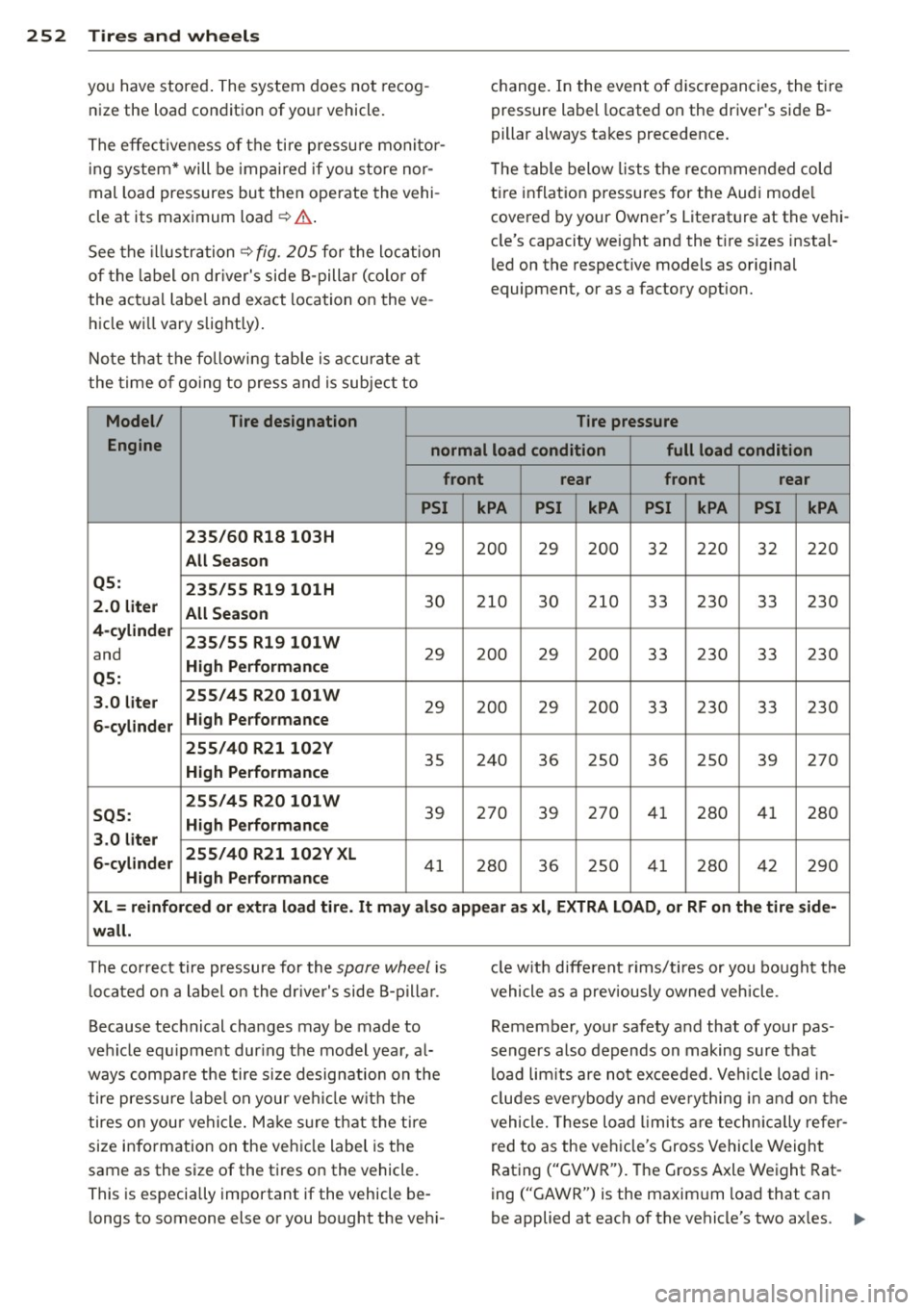
252 Tire s and wheel s
you have stored . The system does not recog Ā
nize the load condition of your vehicle.
The effectiveness of the tire pressu re monito rĀ
ing system* will be impai red if you store nor Ā
mal load pressures but then operate the vehi Ā
cle at its maximum loadĀ¢.&. .
See the illustrationĀ¢
fig. 205 for the location
of the label on dr iver's side 8-pillar (color of
the actua l labe l and exact location on the veĀ
hicle wi ll vary slightly) .
Note that the followi ng tab le is accurate a t
the time o f go ing to press and is subject to
Model / Tire de
signation
change. In the event of discrepancies, the t ire
pressure label located on the driver's side 8-
pillar always takes precedence .
T he table below lists the recommended cold
ti re inflation pressu res for the Audi mode l
covered by your Owner's Literat ure at the vehiĀ
cle's capacity weight and the t ire sizes instalĀ
l ed on the respective models as orig inal
equipment, or as a factory option.
Tire pressure
Engine normal load condition full load condition
front rear
front rear
PSI kPA PSI kPA PSI kPA PSI kPA
2 3 5/60 R18 103H
29 200 29 200 32 220 32 220 All Season
Q5 :
235/ 55 R19 101H
2 .0 liter
All Season
30 210
30 210
33 230
33 230
4-c
ylind er
235/55 R1 9101W
and 29 200 29 200 33 230 33 230 High P erforman ce
QS:
3 .0 l iter 2
55 /45 R 20 101W
29 200 29 200 33 230 33 230
6-cy lind er High Pe
rformance
255 /40 R21102Y
35 240
36 250 36 250 39 270 High Performan ce
25 5/4 5 R20 101W
39 270 39 270 280 280 SQ5:
High Performan ce 41 41
3.0 liter
6-cylind er 255
/40 R21102Y XL
41 280 36 250 41 280 42 290 High Perfo rmance
X L = rei nfo rce d or extra load tir e. It ma y al so a ppea r a s xl , EXTRA LOAD, or RF on th e tire sid e-
wall.
The cor rect tire pressure for the spare wheel is
located on a label on the dr ive r's side 8-pilla r.
Because technical changes may be made to
vehicle equ ipment dur ing the model year, a lĀ
ways compare the tire size designation on the
tire pressure labe l on you r veh icle w it h the
tires on your vehicle. Ma ke su re that the tire
size info rmation on the vehicle label is the
same as the size of the tires on the vehicle.
This is especia lly important if the vehicle beĀ
longs to someone else or you bought the vehi- cle w
ith different rims/t ires or you bought the
vehicle as a prev iously owned vehicle.
Remember, your safety and that of your pas Ā
sengers also depends on making sure that
load lim its are not exceeded. Vehicle load inĀ
cludes eve rybody and everyth ing in and on the
vehicle. These load l imits a re techn ica lly referĀ
red to as the vehicle's Gross Vehicle Weight
Rating ("GVWR"). The Gross Axle Weight RatĀ
ing ("GAWR") is the maximum load that can
be applied at each of the vehicle's two axles . .,_
Page 260 of 316
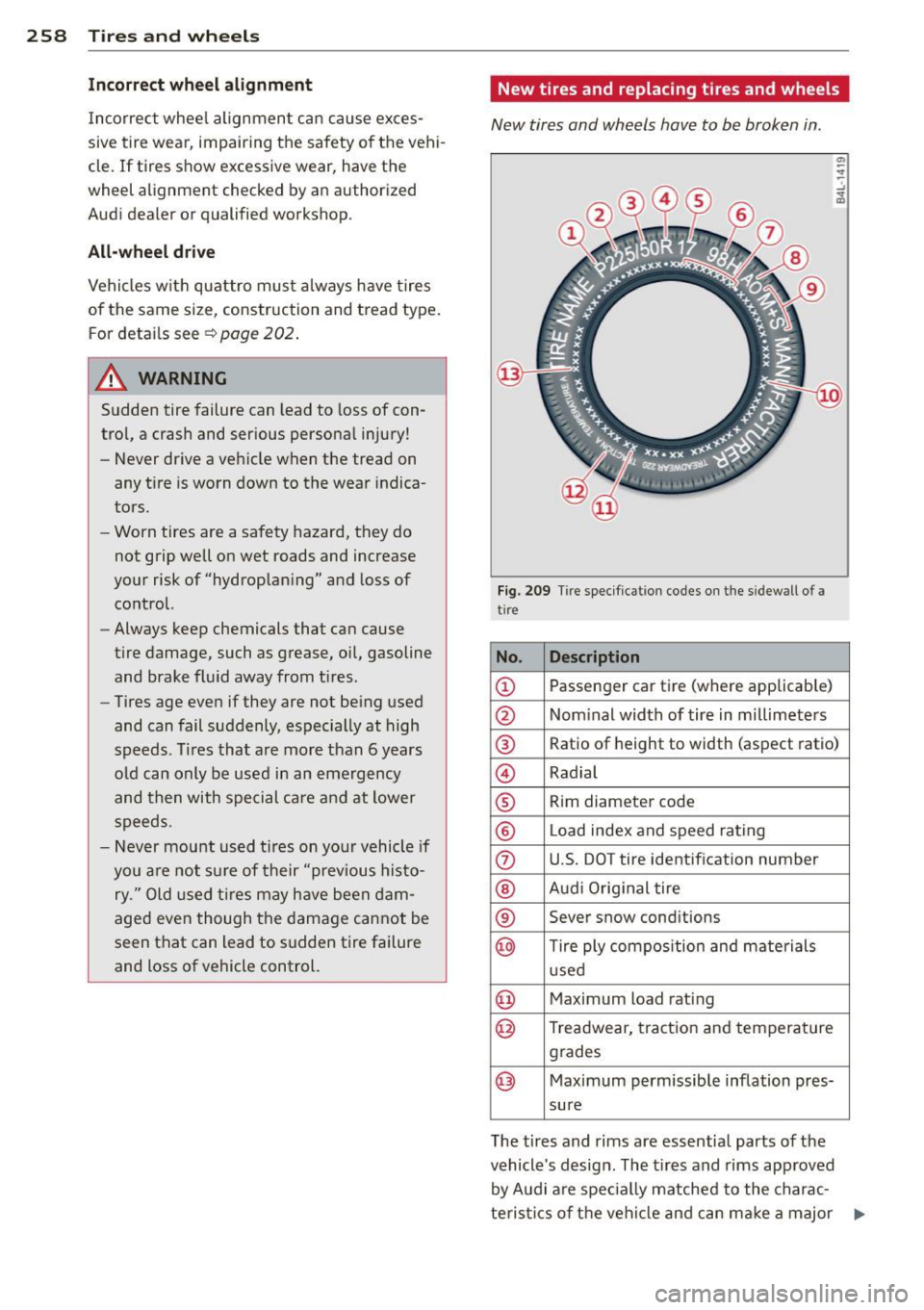
258 Tires and wheels
Incorrect wheel alignment
Incorrect wheel alignment can cause excesĀ
sive tire wear, impairing the safety of the vehiĀ
cle . If tires show excessive wear, have the
wheel alignment checked by an authorized
Audi dealer or qualified workshop .
All-wheel drive
Vehicles with quattro must always have tires
of the same size, construction and tread type.
For details see Qpage 202 .
.&_ WARNING
Sudden tire failure can lead to loss of conĀ
trol, a crash and serious personal injury!
- Never drive a vehicle when the tread on
any tire is worn down to the wear indicaĀ
tors.
- Worn tires are a safety hazard, they do
not grip well on wet roads and increase
your risk of"hydroplaning" and loss of
control.
- Always keep chemicals that can cause
tire damage, such as grease, oil, gasoline
and brake fluid away from tires.
- Tires age even if they are not being used
and can fail suddenly, especially at high
speeds. Tires that are more than 6 years
old can only be used in an emergency
and then with special care and at lower
speeds.
- Never mount used tires on your vehicle if
you a re not sure of their "previous histoĀ
ry." Old used tires may have been damĀ
aged even though the damage cannot be
seen that can lead to sudden tire failure
and loss of vehicle control.
New tires and replacing tires and wheels
New tires and wheels have to be broken in .
Fig. 209 Tir e specificat ion codes on t he s idewall o f a
t ire
No. Description
Ā® Ratio of height to width (aspect ratio)
Ā© Radial
Ā® Rim diameter code
Ā® Load index and speed rating
(J) U.S. DOT tire identification number
Ā® Audi Original tire
Ā® Sever snow conditions
@ Tire ply composition and materials
used
@ Maximum load rating
@ Treadwear, traction and temperature
grades
@ Maximum permissible inflation pres-
sure
The tires and rims are essential parts of the
vehicle's design . The tires and rims approved
by Audi are specially matched to the characĀ
teristics of the vehicle and can make a major .,..
Page 263 of 316
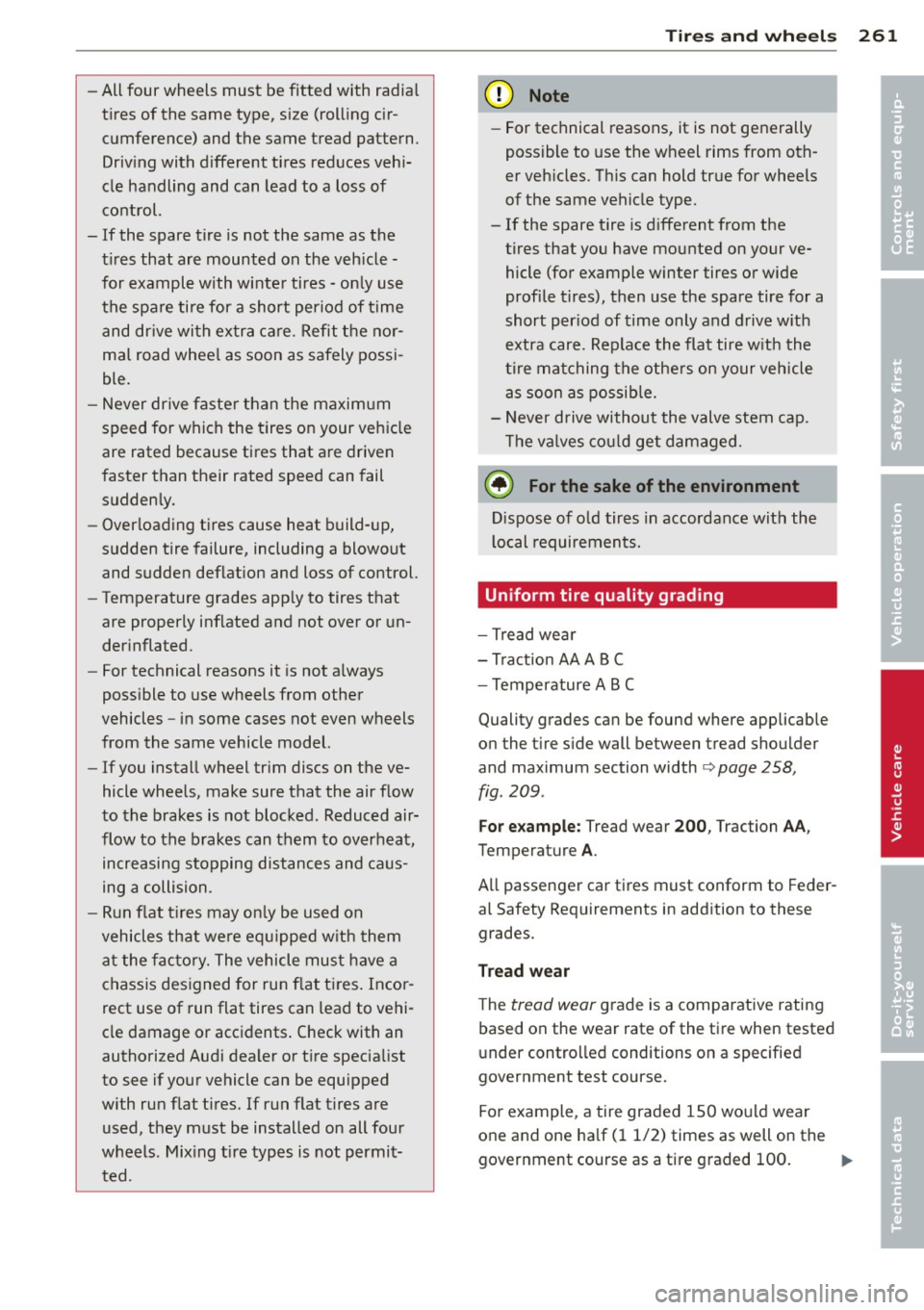
-All four wheels must be fitted with radial
tires of the same type, size (rolling cirĀ
cumference) and the same tread pattern .
Driving with different tires reduces vehiĀ
cle handling and can lead to a loss of
control.
- If the spare tire is not the same as the
tires that are mounted on the vehicle -
for example with winter tires -only use
the spare tire for a short period of time and drive with extra care. Refit the norĀ
mal road wheel as soon as safely possiĀ
ble.
- Never drive faster than the maximum
speed for which the tires on your vehicle
are rated because tires that are driven
faster than their rated speed can fail
suddenly.
- Overloading tires cause heat build-up,
sudden tire failure, including a blowout
and sudden deflation and loss of control.
- Temperature grades apply to tires that
are properly inflated and not over or unĀ
derinflated .
- For technical reasons it is not always
possible to use wheels from other
vehicles -in some cases not even wheels
from the same vehicle model.
- If you install wheel trim discs on the veĀ
hicle wheels, make sure that the air flow
to the brakes is not blocked. Reduced airĀ
flow to the brakes can them to overheat,
increasing stopping distances and causĀ
ing a collision.
- Run flat tires may only be used on
vehicles that were equipped with them at the factory. The vehicle must have a
chassis designed for run flat tires. IncorĀ
rect use of run flat tires can lead to vehiĀ
cle damage or accidents. Check with an
authorized Audi dealer or tire specialist
to see if your vehicle can be equipped
with run flat tires. If run flat tires are
used, they must be installed on all four
wheels . Mixing tire types is not permitĀ
ted.
Tires and wheels 261
@ Note
- For technical reasons, it is not generally
possible to use the wheel rims from othĀ
er vehicles. This can hold true for wheels
of the same vehicle type.
- If the spare tire is different from the
tires that you have mounted on your veĀ
hicle (for example winter tires or wide
profile tires), then use the spare tire for a
short period of time only and drive with
extra care. Replace the flat tire with the
tire matching the others on your vehicle
as soon as possible.
- Never drive without the valve stem cap .
The valves could get damaged.
(Ā® For the sake of the environment
Dispose of old tires in accordance with the
local requirements.
Uniform tire quality grading
- Tread wear
- Traction AA A B C
- Temperature ABC
Quality grades can be found where applicable
on the tire side wall between tread shoulder
and maximum section width
Ā¢ page 258,
fig. 209.
For example: Tread wear 200, Traction AA,
Temperature A.
All passenger car tires must conform to FederĀ
al Safety Requirements in addition to these
grades.
Tread wear
The tread wear grade is a comparative rating
based on the wear rate of the tire when tested
under controlled conditions on a specified
government test course.
For example, a tire graded 1S0 would wear
one and one half (1 1/2) times as well on the
government course as a tire graded 100. ā¢
ā¢
Page 265 of 316

was manufactured. Please see Ā¢ page 259,
Speed rating (letter code) for a listing of the
speed rat ing letter codes and the maximum
speed at which the tires can be driven .
The speed rating letter code(Ā¢
page 250) is
on the side wall of the tire
c::> page 258.
A WARNING
Winter tires have maximum speed limits
that may be lower than your vehicle's maxĀ
imum speed. Always know the maximum
speed before driving off . Never drive faster
than the speed permitted for your specific
w inte r tires . This will cause damage to the
tires leading to an ac cident and serious
pe rsonal inj ury to you and yo ur passenĀ
gers .
A WARNING
Driv ing faster than the maximum speed
for which the winter tires on your vehicle
were designed can ca use tire fai lure inĀ
cl uding a blowout and sudden deflat ion,
loss of control, crashes and serious perĀ
sonal injuries . Have worn or damaged tires
rep laced immed iate ly.
- Winter tires have maximum speed rat ing
that may be lower than your veh icle's
maximum speed .
- Never drive faster than the speed for
w hich the winter or other tires installed
on your veh icle are rated .
A WARNING
Always adjust your d rivi ng to the road and
traffic conditions. Neve r let the good acĀ
c eleration of the w inte r ti res and all-whee l
drive temp t you in to taking extra r is k s . A lĀ
ways remember:
- When bra king, an a ll-wheel d rive vehicle
hand les in the s ame way as a front drive
vehicle.
- Drive carefu lly and reduce your speed on
icy and slippery roads, even winter tires
cannot he lp under blac k ice conditions.
Tire s an d wheel s 263
'
@) For the sake of the environment
Use summer tires when weather condiĀ
tions permit. They are qu ieter, do not wear
as quickly and reduce fuel consumpt ion.
Snow chains
Snow cha ins may be fitted only to the rear
wheels, and o nly to certain tire sizes . Ask your
autho rized Aud i deale r on which tire sizes
snow cha ins can be used .
The snow chains must have low-prof ile links
and must not be th icker than 0.53 inch
(13.5 mm) , includ ing the lock .
Remove wheel center covers and trim discs
before putt ing snow cha ins on your vehicle
c::> Q) . For safety reasons cover caps must then
be fitted over the wheel bolts. These are ava ilĀ
able from autho rized Aud i dealers.
A WARNING
Using the wrong snow chai ns for your vehiĀ
cle o r insta lling them incorrect ly can inĀ
crease the risk of loss of cont ro l leading to
serious personal injury.
- Snow chains are available in different
sizes. A lways make sure to follow the inĀ
structions p rov ided by the snow chain
manufacturer.
- When driving with snow chains never
drive faster than the speed permitted for
your specif ic snow chains.
- Always observe local regulations .
(D Note
-Remove snow chains before dr iv ing o n
roads not covered with snow to avoid
damaging tires and wea ring the snow
chains down unnecessarily.
- Snow chains, which come into direct con Ā
tact with the whee l rim , can scratch or
damage it . Therefore, make sure that the
snow chains are suitably covered. Check
the pos ition of the snow chains after
ā¢
ā¢
Page 267 of 316
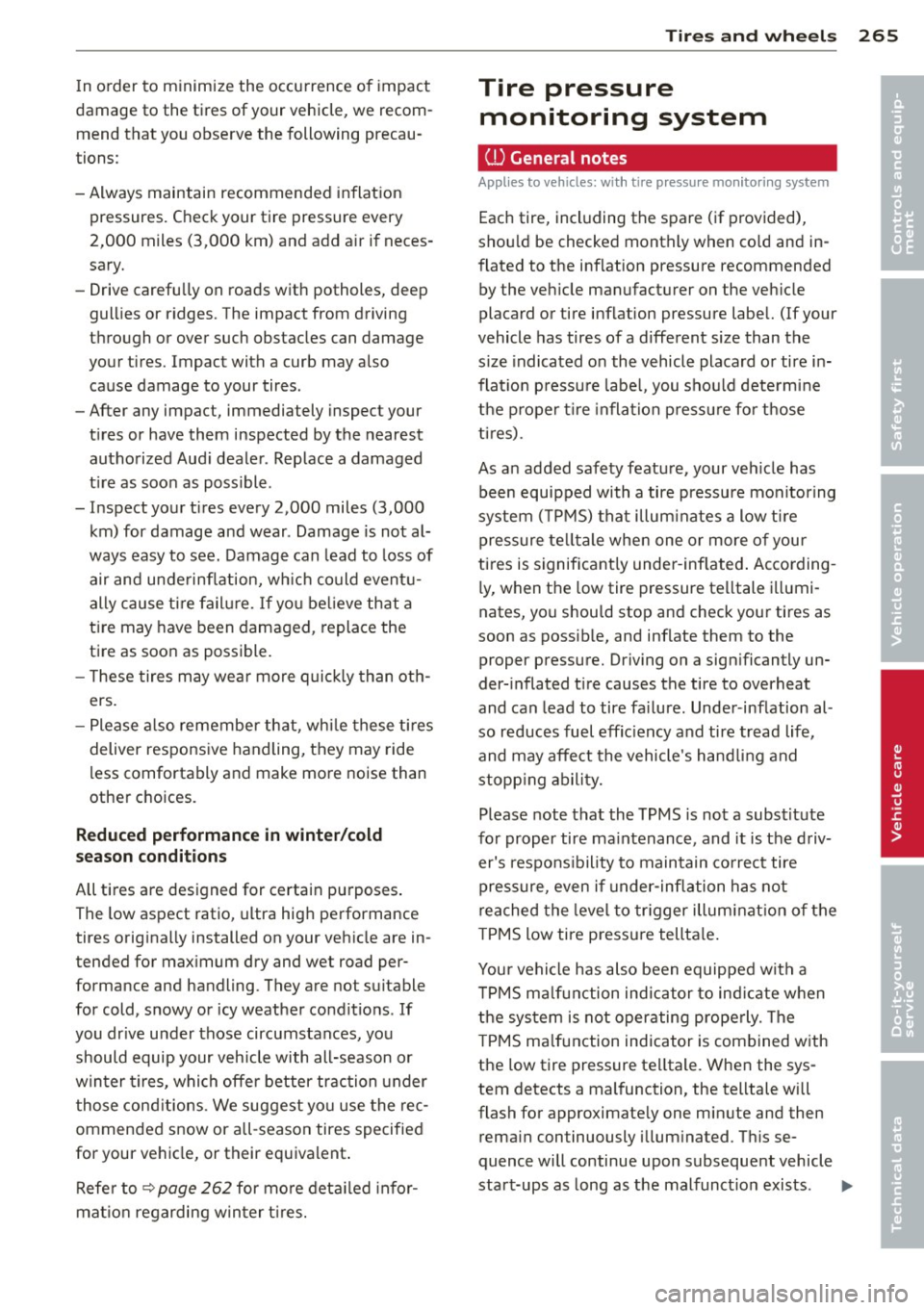
In o rder to minimize the occurrence o f impact
damage to the tires of your vehicle, we recomĀ mend that you observe the following precauĀ
tions :
- Always maintain recommended inflation
pressures. Check your tire pressure every
2,000 miles (3,000 km) and add a ir if necesĀ
sary.
- Drive carefu lly on roads with potholes, deep
gullies or ridges. The impact from driving
through or over such obstacles can damage
your tires. Impact with a curb may also cause damage to your tires .
- After any impact, immediately inspect your
tires or have them inspected by the nearest
authorized Aud i dealer . Replace a damaged
t ire as soon as poss ible .
- In spect your t ires every 2,000 miles (3,000
km) for damage and wear . Damage is not alĀ
ways easy to see. Damage can lead to loss of
air and unde rinflation, wh ic h could eventuĀ
ally cause ti re fail ure.
If yo u be lieve that a
ti re may have been damaged , replace the
tire as soon as possible.
- These tires may wear more quick ly than oth Ā
ers.
- Please a lso remembe r that, whi le these t ires
deliver respons ive handling, they may ride
less comfortably and make more noise than
other c hoices.
Reduced p erformance in winter /cold
s ea son condit ion s
All ti res are designed for certain purposes .
The low aspect ratio, ultra hig h performance
tires originally installed on your veh icle are inĀ
tended for max imum dry and wet road perĀ
formance and handling . They are not suitable
for cold, snowy or icy weather cond it ions . If
you dr ive under those circumstances, you
should equip your vehicle with all-season or
winter tires, whi ch offe r better traction under
those cond it ions . We suggest you use the recĀ
ommended snow or all -season tires specified
for your ve hicle, or their equiva lent .
Refe r to ~
page 262 for mo re deta iled info rĀ
mat io n regarding w in ter t ires.
Tire s an d wheel s 265
Tire pressure
monitoring system
ill General notes
App lies to vehicles : wi th tire p ress ure mo nito rin g system
Each tire, incl uding the spare (if provided),
shou ld be checked monthly when co ld and in Ā
flated to the inflation pressure recommended
by the veh icle manufacturer on the veh icle
placard or tire inflation pressure label. (If your
vehicle has tires of a d ifferent size than the
s iz e indicated on the vehicle placard or tire inĀ
flat io n pressu re labe l, you shou ld dete rmine
the p roper t ire inflation p ress ure fo r those
t i r es).
As an added safety feature, your veh icle has
been equipped with a tire pressure monitoring
system ( TPMS) that illum inates a low ti re
pressure te lltale whe n one or more o f your
ti res is significant ly under -inflated . AccordingĀ
ly, when the low tire pressure te lltale i llumiĀ
nates, you shou ld stop and check your tires as
soon as possib le, and inflate them to the
proper pressure. Driving on a sign ificantly unĀ
der- inflated t ire causes the tire to overheat
and can lead to tire fa ilure . Under-inflation alĀ
so reduces fuel effic iency and tire tread life,
and may affect the vehicle 's hand ling and
stopp ing abil ity.
Please note that the TPMS is not a subst itute
fo r proper tire ma intenanc e, and it is the d rivĀ
er's respo nsibility to maintain co rrect tire
pressure, even if under-inflation has not
reached the leve l to tr igger illum inat ion of the
T PMS low ti re p ressu re tellta le .
You r vehicle has also been equipped with a
T PMS ma lf u nction indicator to ind icate w hen
the sys tem is not operating prope rly . T he
T PMS ma lfunction indicator is combined w ith
the low tire pressure te lltale. When the sys Ā
tem detects a malfunction, the telltale wi ll
flash for approximate ly one min ute and then
rema in con tinuously i llum inated . T hi s seĀ
quence will continue upon subsequent vehicle
start-ups as long as the malfunct ion exists . ..,.
ā¢
ā¢